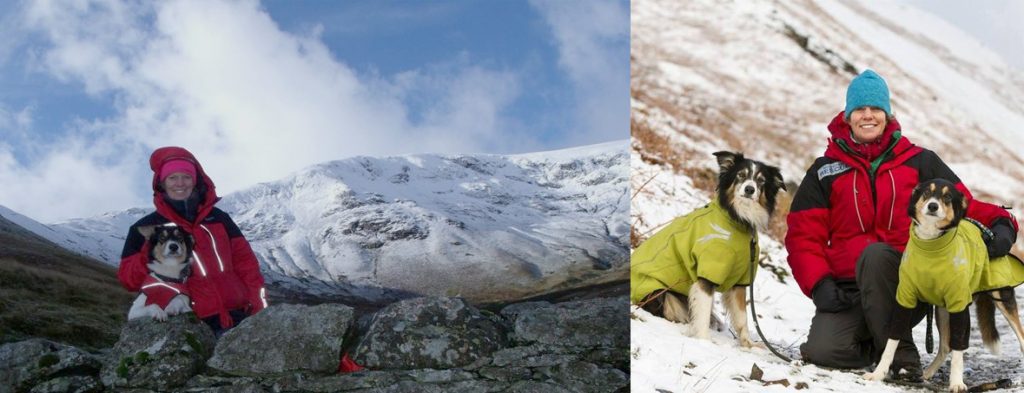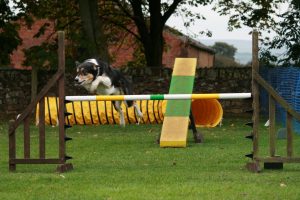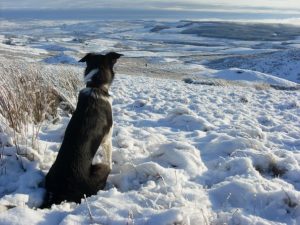Canine Careers: Search and Rescue Dogs
23/03/2018
Over the next few months, Gilbertson & Page will highlight some of the careers that our canine friends undertake, from guide dogs to police dogs. This month, we’re looking at the vital role search and rescue dogs play and the work involved in training them. We spoke to Karen Fisher, who trains search and rescue dogs in Teesdale, to find out more.
Hi Karen, could you start by telling us a bit about how you got into training search and rescue dogs?
I rescued a terrier and started training her for agility and found I loved training dogs. At that time, I had been in the Mountain Rescue team for 8 years so I asked if I could get a dog and train it as a search dog. To be honest, at that time I hadn’t really thought about the end result, ie the stress of searching for a missing person for real. I was just wrapped up in the aura of training the dog. Now I just love training and working dogs, they are amazing.
How many search and rescue dogs have you trained? Do you have a favourite?
One and a half! Search dog Sam is my first search dog and it was 8 years ago that I trained him, so I think I now have rose-tinted glasses in believing he was just perfect. The ‘half’ is my new dog, Gus, who is now in training. I got him from Ireland at 4 months old. I did have great trouble in getting him to be play-motivated and want to play with humans. Play is essential in our training as we use this as the reward. I had to give up on the search and rescue training for 6 months and just concentrate on play! We now have it and we have resumed search training.
I definitely couldn’t pick a favourite. We have five dogs in all and have worked four of them. Each of them is fabulous in their own way. I love them all.
What is Sam’s story?
Sam was found as a stray and taken to Battersea Dogs’ Home. They looked after him for three months before sending him to Donna Caine at Morgan’s Dog Rescue in Alston, Cumbria. I was looking for a tri-coloured male collie ‘with drive’ because I had the opportunity to train a search and rescue dog with SARDA (Search and Rescue Dog Association). Donna introduced me to Sam and that was it. Unknown to me, before Sam left Battersea, he had been filmed for a dog adoption drive advert for which Neil Morrissey did the voice-over. Sam was picked for the next set of adverts showing him happy in his new home. From this he became a little bit of a celebrity. We got to go to Crufts where we met Neil Morrissey and Ben Fogle. And he wasn’t even a year old yet!
We started search and rescue training and Sam also enjoyed training and competing at agility during this time. Since passing the novice grading to become operation, Sam has found four people, saving three lives. He has also spent a lot of time in schools, community centres, clubs and societies, showing off what he does and raising money for SARDA. He has also reached Grade 7 in agility, qualified for and competed at Olympia and competed in championship agility shows.
Now he is ten, his age is starting to show a little. He still loves his search and rescue work and competing at agility, but will be thinking about retiring in about two year’s time. This is where Gus comes in, again from Morgan’s Dog Rescue.
Are particular breeds more suited to being search and rescue dogs?
Most operational dogs are collies, because we are tapping into their natural abilities. For years, collies have been bred to have the agility and stamina to herd sheep on the fells. We are using the dog’s natural instincts to hunt out the human scent of a missing person. Collies are not the only breed of dog that are operational search dogs, however, we also have several spaniels, German Shepherds and Labradors.
Is there an optimal age for training a dog?
Most of the dogs that go through training start as soon as they have had all their injections and can go on a SARDA national training course. However a few handlers, including myself, choose to rescue dogs, so some dogs start any age up to three years old.
What does search and rescue training involve and how long does it take?
Search and rescue training in a nutshell is teaching the dog to play hide and seek. I use the word ‘play’ because, for the dog, from the start of training to a real search the process is no more than a game to hunt out human scent to find a hidden/missing person, which results in them playing with their favourite toy.
Training starts with basic obedience and a stock (sheep) test. Our search dogs work off lead often at some distance from the handler. Therefore we must have the confidence that our dogs will not chase stock. This is the registration. Once the dog passes the registration, it moves on to the find sequence in stage 1. The ‘find sequence’ is when the dog runs backwards and forwards from the missing person and handler, barking to indicate the find to the handler.
When the find sequence has been consolidated and assessed, the dog team moves to stage 2. At stage 2 the dog learns to hunt out human scent to find the missing person and then complete this with a find sequence. At this stage the handler would know the location of the missing persons. These missing people are wonderful volunteers called ‘dogsbodies’. They lie out on the fell for hours waiting for trainee search dogs to find them. Knowing where the dogsbodies are enables the handler to support and help the dog to learn in a positive manner. For stage 2 assessment the dog team completes a half hour search area.
This moves the dog team into the third and final stage. At this stage, the handler will no longer know in training where the missing persons (dogsbodies) are and they’re working the area ‘blind’, as we call it. The length of time that the dog is expected to work is increased until they are working for 2 hours. For the dog team to become operational, they will undertake a pre-assessment, which will consist of four 2 hour search areas over two days. If successful they will be invited to an annual assessment weekend. Here, they will have to successfully complete five 2 hour search areas.
As all the search and rescue dog handlers are volunteers, most with full time jobs, the training has to fit into daily life. It generally takes about 2 1/2 years to train a dog to operational standard.
What is the role of search and rescue dogs in a rescue?
The dog team is an additional resource that the search manager has at their disposal when formulating a search plan for a missing person. It has been said that a dog can cover the same area as 20 foot team members! Therefore they can be a valuable resource to a Mountain Rescue Team especially in poor visibility or at night. However, dogs are not infallible, dogs can still miss.
What is your most memorable rescue? Have there been any particularly challenging rescues?
Our most memorable rescue occurred 10 days after grading and becoming an operational dog team. At 1am in the morning, the phone went and we were on our first proper call out. Not only this, but Sam made his first find! Unfortunately the missing person had deceased, but Sam worked really well. The most challenging or difficult searches tend to be the ones where we are looking for missing children.
Thank you for talking to us, Karen.
All photographs are courtesy of Karen Fisher.
- Categories
- A Dog's Life
- Arkwrights Beef
- Arkwrights Chicken
- Breed Guides
- Dog Nutrition & Health
- Dog Shows & Events
- Dr John Gold
- Dr John Grain-Free
- Dr John Hypo Lamb and Rice
- Dr John Hypoallergenic
- Dr John Puppy
- Dr John Silver Beef
- Dr John Silver Chicken
- Dr John Titanium
- G & P Dog Feeds
- Gilpa Kennel
- Gilpa Slimline
- Gilpa Super Mix
- Gilpa Trinkets
- Gun Dogs
- Latest Articles & News
- Other Dog Articles






